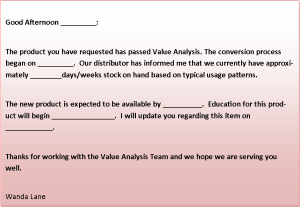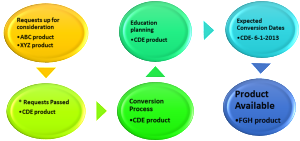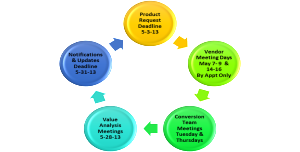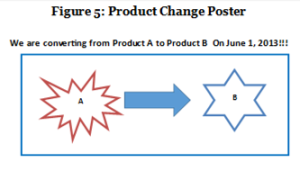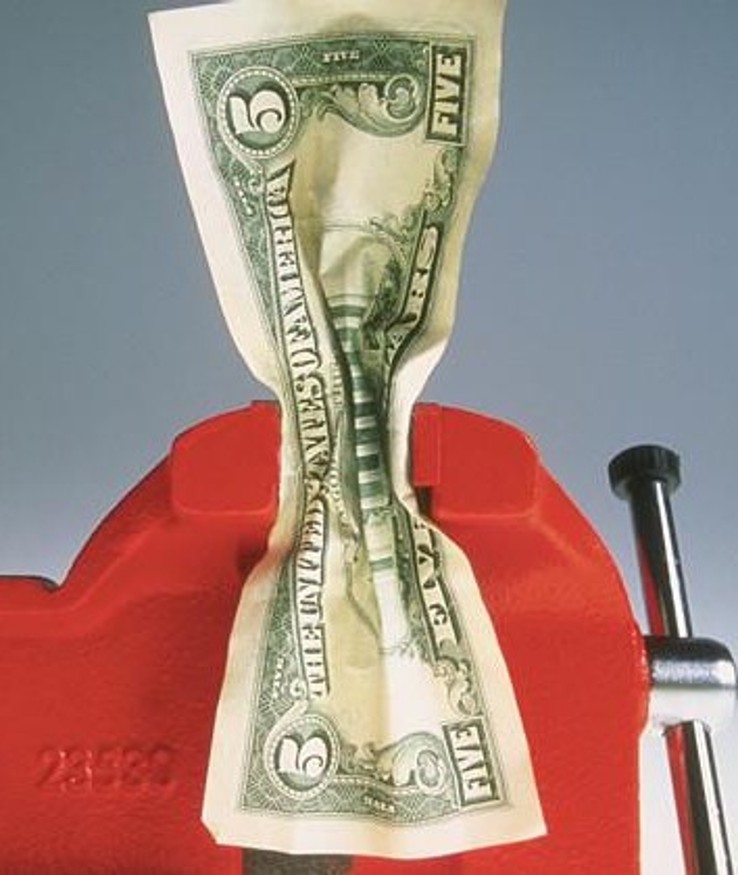Tips and tools to enhance your VA communication and productivity – Part 2
By Wanda-Dupree Lane, RN, BSHA, MaED, Clinical VA Coordinator, The Regional Medical Center, Memphis, TN
The most valuable tool for improving communication is the template. Develop templates like figure 2 for communication tasks based on the feedback from your surveys and productivity spreadsheets. If one of the survey items reveals an information gap regarding time between request and availability, develop an email template with specific information included and set a reminder to inform the requestor bi-weekly.
Figure 2 Sample Communication Template
This communication assures the requestor that his product was considered and provides expected dates for completion, including an explanation for delayed availability. Clinicians may have no idea that logistical issues determine product availability; thus in this culture of immediate gratification, this information satisfies the anxiety caused by delay.
Another useful template to develop is a conversion table. Developing a template to use during the conversion process promotes accountability, visibility to obstacles and challenges, and supports transparent conversion processes. Simple formatting and repetitive use of this template will foster a sense of routine, alleviating the sense of controlled chaos that often accompanies conversions.
Figure 3: Conversion Graphic
Graphic tools
Develop a conversion graphic (figure 3) that clearly illustrates where a product lies in the process. Consider posting this graphic on the Value Analysis landing page on your facility’s internal website or on a whiteboard in an accessible location in the facility. This at-a-glance tool provides assurance that the request is in queue and promotes accountability in managing the process.
Another graphic tool that assists in communication and defines boundaries with product requests is a Request Cycle Graphic (Figure 4) with dates assigned monthly, made visible to clinicians, physicians, and vendors. This graphic closes the gap on product request deadlines, eliminates repetitive questions, and establishes guidelines for all parties involved.
Figure 4: Request Cycle Graphic
Placement of this graphic should not coincide with Conversion Graphic as this pertains to vendors as well as staff. This type of graphic could be placed on the VA web page, but also displayed in the Purchasing office or at check-in kiosks.
The final graphic is a simple product change poster (figure 5) used to alert all staff members of a product or labeling change. In this case, a photograph of the current product is placed next to a photograph of the new product with an arrow and wording to indicate the action.
Implementation
If your facility doesn’t have these tools in place, consider an implementation strategy beginning with the survey and benchmarking information. Develop the tools approved by your team and begin implementation. After the tools are in place for 90 days, track the same information on the tool used for benchmarking. If productive time is increasing and redundancy is diminishing, repeat the survey. If not, tweak your tools to address the gap that remains. After six months, repeat the survey and look for patterns. Compare the results to the previous survey and assess successes and challenges. Position the communication tools as a Value Analysis service upgrade and promote positive response with communication saturation. Starting strong with the tools and templates will bring visibility to your team and the progress made.
Conclusion
Value Analysis communication is multi-faceted and complicated. By using consistency and simplicity, acknowledging the three P’s of communication, and implementing tools such as the templates included in this article, your team will achieve maximum productivity in minimal time.
Wanda Dupree Lane is the Value Analysis Coordinator at the Regional Medical Center at Memphis, TN. Wanda has been a registered nurse for 26 years, vendor representative for five years, and business owner for several years. During that time, Wanda has watched healthcare perceptions and actions change with a unique perspective. In her current position, Wanda has enjoyed watching her hospital’s Value Analysis program grow and develop. The program continues to evolve, seeking new and innovative ways to meet customers’ needs and provide the best possible care in the most fiscally responsible manner. You can contact Wanda with your questions or comments at WLane@The-MED.org, or call her at 901-545-8662.


